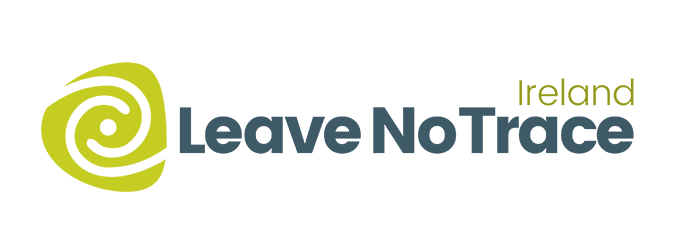Leave No Trace – Responsible and Sustainable Tourism when Visiting Monuments in Ireland
Encouraging responsible and sustainable tourism is central to our mission for Tuatha. We are a team of experienced archaeologists, who are lucky enough to have spent a lot of our time researching and visiting monuments all over Ireland. One of the great things about Ireland, that is a little different to elsewhere, is that there is often a very unadulterated experience when visiting sites, outside of a few particularly notable places like the Rock of Cashel, Newgrange or Glendalough. In many cases, a directional fingerpost and a stile over a farm fence is all that might indicate that there is something worth seeing. If you are lucky, there may be an interpretation panel that gives a short description. This casual accessibility of much of our monuments means that you can often find you have the place all to yourself, allowing you to soak in the atmosphere.
However this same casual accessibility makes the monuments vulnerable. In recent years, increasing numbers of archaeological and historical sites around Ireland have been damaged, vandalised and even plundered by illegal metal detectorists. While many of these acts were committed deliberately, others may have been the result of accidental damage, or a thoughtless action carried out without intent to do harm. For example, many people climbing the summit of Knocknarea Mountain may go that extra bit further by clambering to the top of the large cairn of stones, without realising that they are causing serious damage to a 5,000+ year old passage tomb.
This page sets out our policy regarding accessing monuments, with some ideas and guidelines about sustainable and responsible tourism, following Leave No Trace principles and the relevant legislation that safeguards our heritage. Our archaeological and historical heritage belongs to all of us, and the intention of this page isn’t about telling people that they can’t have fun visiting sites, but to ask people to be mindful that some of these monuments have stood there for millennia. We need to do our part to mind them if we want our children’s grandchildren to enjoy them too.
Neil Jackman, licensed archaeologist and director of Tuatha and Abarta Heritage.
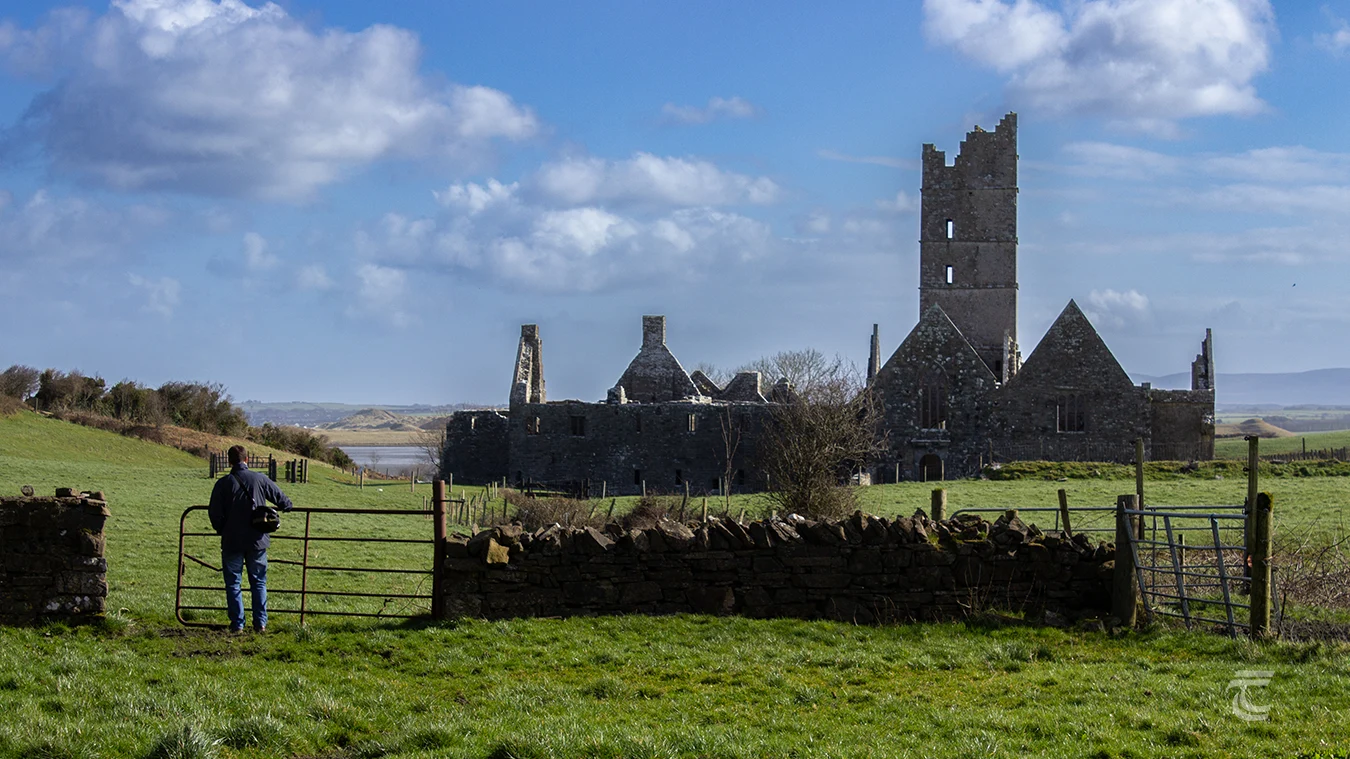
Responsible and Sustainable Tourism
What is Sustainable and Responsible Tourism, and why does it matter?
In our work at Abarta Heritage, we have had the opportunity to work with a number of communities, local authorities and national bodies to help to foster a culture of sustainable tourism. Terms like Sustainable Tourism and Responsible Tourism have become commonly used in recent years, as people in general have become more concerned about their impact on the world. As a concept ‘sustainable tourism’ is a little more cohesively understood to mean to take into account your impact on the climate and local environment when travelling. Taking less flights, using more public transport, cleaner fuel, cycling and walking all help you to travel more sustainably. As does the choice of businesses and accommodation that you support. Whereas ‘responsible tourism’ is a more subjective and debated term. We understand it to both encompass some of the same environmental choices covered by ‘sustainable tourism’ but also to include issues like our personal behaviour at particular places. It includes sensitivity towards local cultural norms, and avoiding places or businesses that may be exploiting workers or having a detrimental impact on the locality or environment.
One of the best ways that we try to help people to enjoy Ireland by travelling more sustainably and responsibly is to provide information on public transport on our article search page, as well as resources and encouragement for you to dwell longer in a particular place or landscape, rather than rushing from one end of the island to the other. To us, ‘checkbox tourism’, where you are more focused on ticking sites off a list, is less enjoyable than taking the time to get under the skin of a place. That’s why many of our itineraries feature a famous place, while including a number of other lesser known (but equally great) monuments nearby. Take our Rock of Cashel Route for example, that helps to immerse you in the local landscape after you visit the famous Rock. With hidden holy wells, secluded waterfalls and atmospheric ancient monasteries to discover. Dwelling longer in a place helps you to understand the context of these famous sites. To discover more about the landscape, and best of all, to meet the locals. So where you can, support local businesses, tour guides and communities. That helps them to develop their offerings, making it both a better place to live, and a better place to visit.
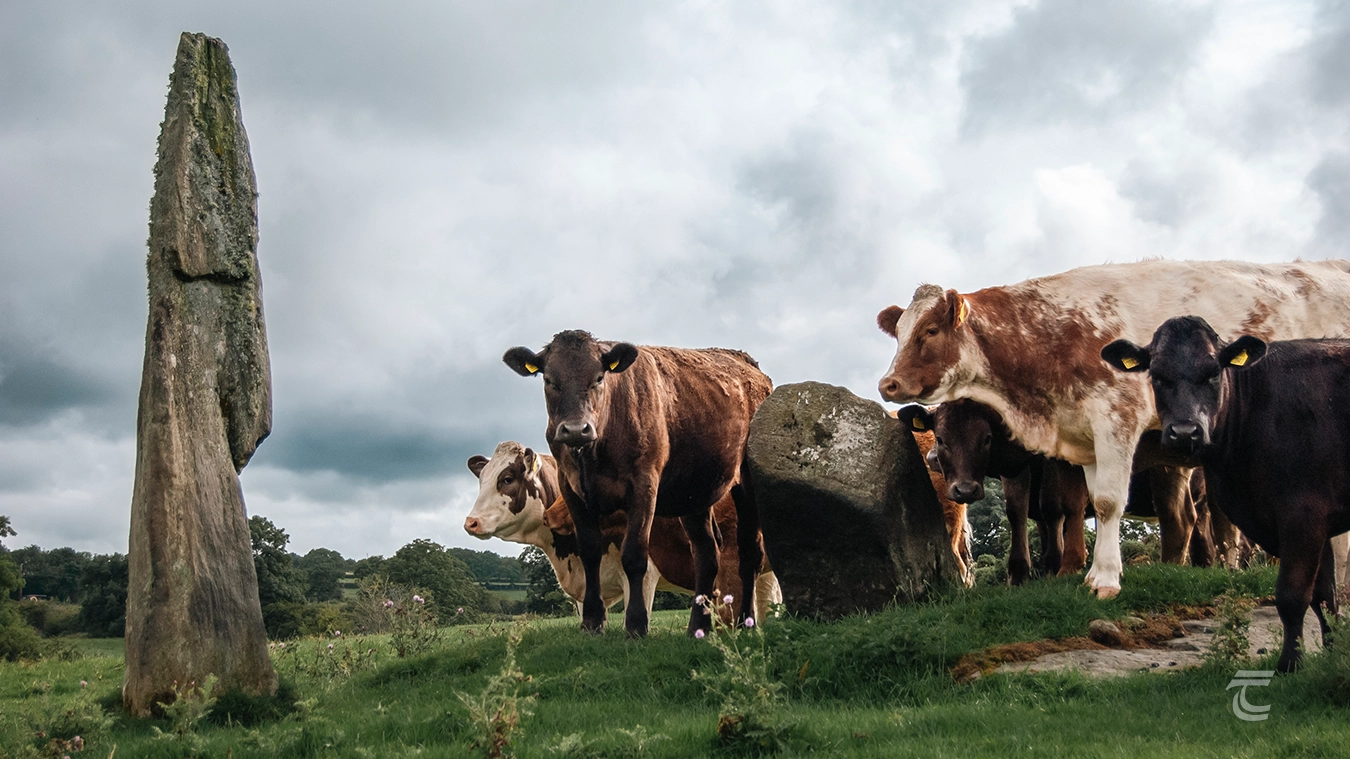
Protecting Our Past – Visiting Monuments in Ireland
Seek landowner permission when visiting a site on private property.
Many of our incredible sites across Ireland have been preserved and protected thanks to private landowners. We make sure to provide you with the best advice on access in all our articles on sites, and give information based on recent visits. However, access rights can change rapidly, and it’s always a good idea to check with the landowner first if you’re not certain, and to follow all instructions given. In general, if a site has a directional sign and a stile or gate to access, it is usually a good indication that the landowner welcomes visitors. Where you are allowed to access, please respect the landowner by ensuring you close all gates behind you, leave any fences as found and leave no trace. If you see livestock in the field, either do not enter, or detour around so you will not disturb them. Always ensure that you park your car in such a way that you do not obstruct any gates, entrances or the roadway. In rural areas in particular, always try to leave enough room that a tractor can pass. Even if this means leaving the car a little walk away from the site. If I feel like there’s a chance that my car might be in the way, I leave a note visible on my dashboard, with “If in the way, please call” and my mobile number.
However if you see a monument, and there is no clear access beyond a farm gate with a ‘No Trespassing’ sign, that is a pretty clear indication that they do not allow the public to enter. This isn’t usually because the landowner is a curmudgeon who doesn’t like people, but there can be important practical considerations. They may have livestock, including a bull, in the field, or they may be worried about a vulnerable relative who may be scared to see strangers on their property, especially if they have experienced a robbery or another traumatic event. They may also be concerned about insurance, and that if a visitor gets injured that they might be in serious financial trouble. There have unfortunately been cases where the misbehaviour of some visitors has led to the landowner closing access to important monuments. Treating the landowner with respect and courtesy is important, and it can lead to unexpected bonuses – who knows the monuments better than those that work the land every day? There have been many times where a chat with the landowner has led to them pointing out another feature or site that I was otherwise unaware of. If we know of a site where we feel there may be landowner concerns about public access, we do not feature them in our articles or itineraries, and we do not encourage people to visit.

Good policies to keep in mind when visiting a monument
Do not bring dogs onto farmland, or where there are notices stating that dogs are not allowed.
This may seem like an obvious point, but there have been a number of disturbing cases where people have abused, or even assaulted, landowners who asked for dogs to be controlled or removed from the land. We are dog owners ourselves, and there are lots of places to go for a good walk with Peig, but we always abide by local signage, and we always ensure that she is on a lead at all times. This is important not just for any potential interactions with livestock or other visitors who may not like dogs, but for the local wildlife. Ground-nesting birds in particular are under enormous pressure from disturbance, particularly along our coastlines. Please keep your dog under control at all times, and leave no trace. Bag all waste and if there is no handy bin, please bring it home with you in an extra bag. You can search for sites that are good to bring your furry friend using our Places to Visit filters.
Dispose of litter responsibly
Please take all litter home with you or dispose of it responsibly. Many sites are not regularly visited and there is no-one appointed to pick up rubbish, so it is every visitor’s responsibility to make sure that they take care of their own litter. As a general policy, where possible it’s always good to try to leave the site in a better state than you found it. If someone else has left litter, and you have the means to do so, please remove it. Think of it as doing a favour to the ancestors – surely a bit of good luck will come your way for it! Though be sure to wear gloves or a litter picker where possible, and don’t take any personal risks to your health. Unfortunately some urban sites, particularly historic graveyards, are often used as places for drug and drink taking as they are so secluded. If needles or other paraphernalia are present then do not try to remove anything, simply alert the local authority instead.
Do not climb on monuments, and do not graffiti
There have been a number of cases in recent years of people leaving their own mark on something that has stood there for thousands of years. From covering the Lia Fáil on the Hill of Tara with paint, to eejits carving their name over 5,000 year old art at Loughcrew, it is tragic to see that some of this damage is easily done but absolutely irreparable. It is not only illegal, it is morally reprehensible, and it profoundly affects future enjoyment of the monument.
A more common and accidental form of damage comes through people climbing on top of monuments, or up the walls of a ruin. They might look stable, but many of our sites, particularly our remote cairns or tombs, are extremely vulnerable. Unless you are told it is safe, climbing on top, or inside, puts both you and the monument at risk.
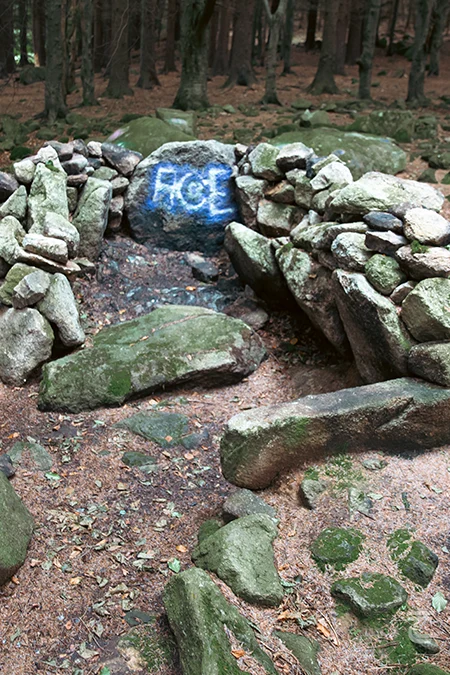
Graffiti and fire damage at a prehistoric tomb in the Dublin Mountains
Do not interfere with monuments and take nothing but pictures
Please do not pick any wildflowers or interfere with local plants or animals when out and about. Even a small disturbance to a site can have a large negative impact on a delicate ecosystem. Make sure to leave all structures, stones, plants, mosses and lichens as you found them. Don’t try to clear off gravestones or to expose features. The moss that may obscure your view may be protecting the delicate lettering of the headstone. Once removed erosion from acid rain may wear away the inscription forever (for more on historic graveyards in particular, please see here). Likewise, do not attempt to cut, poison, or pull any ivy from monuments. Quite often, ivy is the only thing holding the structure together as the traditional mortar may have been washed away over the centuries. Without the advice of an expert conservation architect, and without the legally required permissions, it is both illegal and dangerous to try to interfere with a monument.
When visiting historic monuments, there is always the chance that you may encounter archaeological remains. You may encounter an interesting looking stone, or a seemingly insignificant piece of pottery. But these artefacts may have high significance. That interesting looking stone may be a Mesolithic tool that proves that hunter-gatherers dwelled there thousands of years ago, that piece of ‘insignificant’ pottery might be a small sherd of samian-ware that proves that there were Roman links to that part of Ireland. Taking objects is not only harmful, it is illegal. The National Monuments Act (Amendment) 1987 (further amended in 1994 and 2004) places a legal obligation upon a person who discovers an archaeological object to report such discoveries to the National Museum of Ireland within four days. The National Museum of Ireland is legally obliged to care for these artefacts or to delegate care of the artefact to a designated museum. And rewards may be paid to finders in respect of discoveries, so reporting is the right thing to do.
Do not engage in unlicensed metal detecting
Further to the above point, it is important to state that our monuments have strong legal protection. Be careful not to break the law. The illegal use of metal detectors causes serious damage to Ireland’s archaeological heritage and is subject to severe penalties. Unsupervised recovery of archaeological objects by untrained and unlicensed users of metal detectors can greatly diminish, or can entirely eliminate, any knowledge or research value that might be gained from a particular discovery. Archaeological objects must be excavated in a structured scientific manner, with careful recording of their association with other objects, structures, features and soil layers. Failure to expertly record the context from which an object has been removed results in an irreplaceable loss of knowledge of the past. Random searches with metal detectors cannot determine whether a find is of archaeological importance or if it is a recent discard. The result in either case is that the soil or setting is greatly disturbed and any non-metallic evidence and objects are likely to be destroyed. In addition, artefacts need specialist conservation, exposing them to the air can result in the destruction of the object. Using a metal detector on a national monument site, or even having it in your possession on the site, is illegal, and archaeological objects are the property of the State – ie, the property of all of us – and the appropriate guardian of archaeological objects is the National Museum of Ireland. For more information about the use of metal detectors in Ireland please see here.
If you see someone metal detecting on a monument, please inform the Duty Officer of the National Museum of Ireland (details here) and the local Garda station.
Do not use scramblers, quad bikes or mountain bikes in the vicinity of monuments
Great damage has been caused to a number of monuments by people unwittingly churning them up by driving scramblers or quad bikes over them. Even mountain bikes can have an impact. Their deeply treaded tyres are designed to grip into the ground, and when a particular route becomes popular this can lead to the erosion or damage of earthen features like the banks of a ringfort or enclosure.
Do not climb on monuments
As with the case above, it is easy to cause damage to a monument unwittingly. There are cases, particularly on stone walls or our hilltop cairns like Loughcrew, Knocknarea and Carrowkeel, where people climb on top of the stone mounds. This causes stones to become dislodged, or loosens the drystone structures. And it is a cumulative issue. If one person sees another climb to the top, they follow. Over time, this causes erosion by footfall and leads to the monument becoming damaged. It may even lead to the monument collapsing, dangerous for both the monument and the unlucky person caught in the rockfall.
Do not embellish or create your own ‘monuments’
There is a growing trend of people creating their own monuments in the form of small piles of stones, even copying the monument by making miniature dolmens at sites like Poulnabrone. This impacts the natural habitat of the environs of the monuments, and it detracts from the site itself. It may also be impacting smaller archaeological features that are being unknowingly quarried for their stone. Likewise do not add fairy doors to sites, as in the case I saw recently where someone had attached a fairy door to a 15th century tomb in Tipperary. This is a confected Victorian English view of fairies, not at all in line with traditional Irish beliefs about the Other Crowd, you wouldn’t want to catch Their attention. The site itself is enough, it does not need adornment.
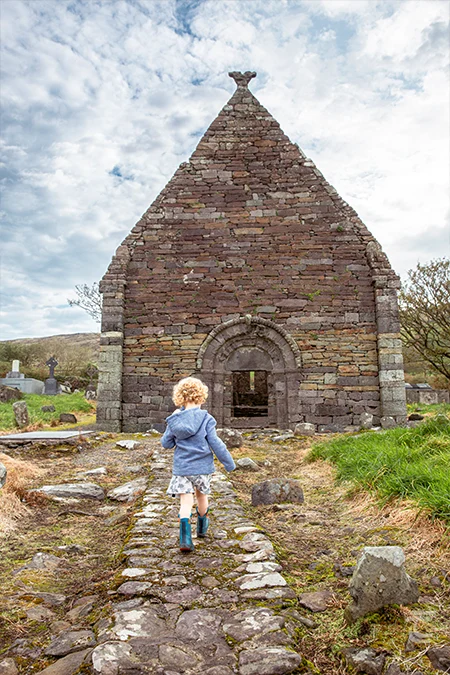
We all need to play our part in protecting the past for future generations to enjoy
Do not leave food or light fires
In recent years there has been a growing interest and appreciation for the spiritual aspect of our monuments, particularly our prehistoric sites. This is warmly welcomed, our monuments have so many meanings for many different people. This is especially true at key times of the year like the solstices. However problems may arise from spiritual practice at our heritage sites. Fire poses the greatest threat. Do not light fires directly on the ground on or immediately adjacent to a monument. It can cause great damage, and it also severely impacts many forms of non-intrusive survey like geophysics. Leaving food offerings is another thing that should be discouraged. It may attract animals (rats for example), making it unsafe for visitors due to threat of Weil’s disease.
Take care not to disturb wildlife
As well as keeping dogs under control, it is important that we try to disturb wildlife as little as possible. There have sadly been a number of cases in recent years where people have had a terrible impact by being thoughtless and valuing their photograph more than the wellbeing of the animal, like the disturbance to the seal colony on the Great Blasket Island. Seal Rescue Ireland have good information on the importance of minimising disturbance on their website. Visiting places like the Great Saltee Island is a wonderful way of getting closer to nature, but there have been times where people have tried to get too close and disturbed the nesting seabirds. Not only does this put people at risk from the likes of avian flu, this can lead to abandonment of nests and chicks, putting increased pressure on already critically vulnerable populations. In short, if you love wildlife, give it space.
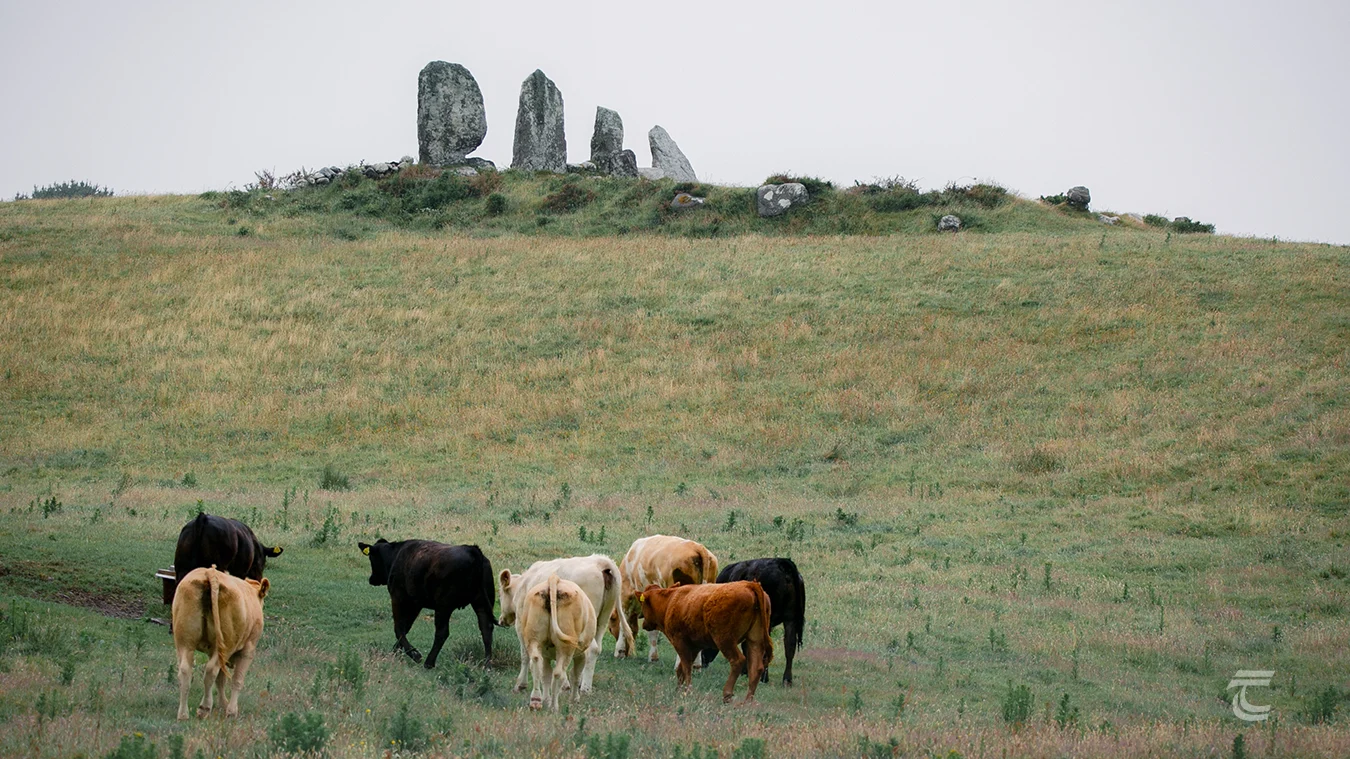
Staying Safe When Visiting Sites
By following the guidelines above, you should be in a good position to avoid causing any danger to the heritage or to yourself. However, there are some specific considerations to keep in mind that will keep you safe, and to help to ensure you have a good visit.
If you are going to a more rural site, make sure you are well equipped
Make sure you have enough supplies for your day. Make sure you have enough water and provisions and that all electronics are fully charged and working. Good footwear (ideally waterproof and with good grips) is essential, as well as a raincoat. Be aware that many of the more remote sites will not have any facilities at all, including refreshments or toilets, and others may only be available seasonally. Even for larger sites, the main tourism season only usually begins after St Patrick’s Day (mid-March) and things begin to wind down around October. We’ve included opening times where they apply in our Places to Visit section.
Visiting isolated or challenging sites
A number of sites are particularly challenging to reach, like mountaintop tombs or isolated coastal forts. Check the weather regularly in advance and dress appropriate to the conditions, always making sure you have a raincoat in the bag at the very least. We recommend using yr.no as a pretty reliable source, but Irish weather can change very quickly. It is always recommended to travel with someone, but if you are by yourself you can still stay safe and enjoy your trip. In advance of your journey, be sure to inform someone of your route, and the timeframe you expect to return and bring a fully charged phone with you.
Precarious monuments and dangerous situations
Be aware that not all monuments are safe to explore, and evaluate carefully the safety of each site before you enter it. Look out for dangers such as livestock, or farm machinery operating. Some structures may be more fragile than they appear, and always take heed of signs and notices. Many of our monuments may be in a particularly precarious state whether through coastal erosion like Dúnbeg Fort, or through collapsing masonry. If the winds are high or if it has been stormy recently, only enter any historic ruin of a stone castle, church or building with extreme care, and do not climb on scaffolding or walls, and do not enter restricted spaces if you are by yourself. Sites can, and do, collapse. If you notice that there has been recent collapse or damage, please inform the National Monuments Service.
Souterrains and caves
I shuddered recently when I saw a TikTok of an influencer merrily entering a newly discovered souterrain. These drystone underground passages are over a thousand years old, and can be exceptionally precarious. If newly uncovered, they can be liable to collapse at any time. Souterrains can also provide a nice home for wildlife, and a badger may not take kindly to being disturbed by someone suddenly bursting into their cosy space. However, there are some examples that are safe to enter. If you wish to descend into a souterrain, be sure that you are with a companion who remains above the surface in case of collapse to raise the alarm and seek help.
Ticks and Lyme Disease
When spending time in the outdoors it is possible that you may encounter some of Ireland’s less pleasant wildlife, horseflies, gnats and the dreaded midge are all a nuisance and may lead to a bite that is sometimes painful, but usually very itchy. Thankfully Ireland has few venomous creatures, but one arachnid does pose a serious risk to health – ticks. They are small parasitic arachnids that usually feed on the blood of birds and mammals (including humans). They are usually most prevalent where there are large populations of wild deer. Killarney National Park being one such place, but they can occur almost anywhere outdoors. They typically bite, gorge on blood and then drop off when they are full. They can go unnoticed until after they have disappeared, leaving you with an itchy bite but no trace of what caused it.
Ticks are particularly dangerous because they can spread Lyme disease (Borreliosis), a bacterial infection transmitted to humans by the bite of an infected tick (not all ticks carry Lyme). It is currently the fastest growing vector-borne disease in the world. Infection starts with a tick bite and symptoms usually follow a few days or weeks after a bite. The first signs are an erythema migrans, or “bulls eye” rash that generally radiates outwards from the source of the bite. Presence of a rash is a strong indicator of infection with Lyme disease although it might not always be present, or it may be very difficult to see on darker skin. Chronic flu like symptoms and fatigue are usually experienced soon after an infection, but if it goes untreated (initial treatment is a strong dose of antibiotics) the full effects of Lyme may take years to become apparent, and can include some serious and life-limiting issues.
The website Tick Talk Ireland has some great information about the dangers and treatment of Lyme disease, and suggestions on how to avoid getting bitten by a tick in the first place. Their advice includes:
• Wear long sleeved t-shirts and trousers when out.
• Tuck your trousers into socks or boots and tuck shirts into trousers to minimise the chance of ticks getting to exposed skin.
• Wear light coloured clothing to make any attached ticks easier to spot.
• Check yourself and children every couple of hours for attached ticks.
• Apply insect repellant with 20%-30% DEET to any exposed skin.
• Can also apply Permethrin to clothing (do not apply directly to skin) which can be bought in camping or hunting shops.
• Avoid wooded areas with tall grass and try to stay in the centre of trails to avoid tree branches, leaves and long grass where ticks usually lie in wait for an unsuspecting victim to brush past.
• Once home check your entire body for ticks. Important areas to check are behind the ears, inside the outer ear, under the arms, behind knees, the trunk of the body and the scalp.
If you find a tick on your body, it is important to remove it gently leaving the tick and its mouthparts intact. Squeezing too hard can cause the tick to regurgitate fluid containing bacteria for Lyme disease among other infections. Instead remove carefully using tweezers, as guided by the excellent advice in Tick Talk Ireland.
Leave No Trace
We are a proud member of Leave No Trace Ireland, and we strongly believe in their mission to promote and inspire responsible outdoor recreation. Their principles are:
1. Plan Ahead and Prepare
2. Be Considerate of Others
3. Respect Farm Animals and Wildlife
4. Travel and Camp on Durable Surfaces
5. Leave What You Find
6. Dispose of Waste Properly
7. Minimise the Effects of Fire
#LoveThisPlace #LeaveNoTrace
